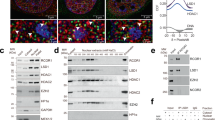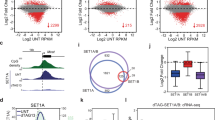Abstract
The new transcriptional coactivator SAYP binds at many sites to transcriptionally active chromatin of polytene chromosomes, colocalizes with RNA polymerase II, and coactivates transcription. On the other hand, SAYP is present in heterochromatic regions of chromosome IV and in the chromocenter and suppresses transcription of transgenes located in heterochromatin. The conserved SAY domain of SAYP is involved in transcription activation, while its PHD domains are responsible for gene silencing in heterochromatin. Thus, SAYP plays a dual role in regulating transcription in euchromatic and heterochromatic regions.
Similar content being viewed by others
REFERENCES
Zhimulev, I.F., Polytene Chromosomes, Heterochromatin, and Position Effect Variegation, Adv. Genet., London: Academic, 1998, vol. 37.
Hwang, K.K., Eissenberg, J.C., and Worman, H.J., Transcriptional Repression of Euchromatic Genes by Drosophila Heterochromatin Protein 1 and Histone Modifiers, Proc. Natl. Acad. Sci. USA, 2001, vol. 98, pp. 11 423–11 427.
Weiler, K.S. and Wakimoto, B.T., Heterochromatin and Gene Expression in Drosophila, Annu. Rev. Genet., 1995, vol. 29, pp. 577–605.
Schotta, G., Ebert, A., Dorn, R., et al., Position-Effect Variegation and the Genetic Dissection of Chromatin Regulation in Drosophila, Semin. Cell. Dev. Biol., 2003, vol. 14, pp. 67–75.
James, T.C. and Elgin, S.C., Identification of a Nonhistone Chromosomal Protein Associated with Heterochromatin in Drosophila melanogaster and Its Gene, Mol. Cell. Biol., 1986, vol. 6, pp. 3862–3872.
Clark, R.F. and Elgin, S.C., Heterochromatin Protein 1, a Known Suppressor of Position-Effect Variegation, Is Highly Conserved in Drosophila, Nucleic Acids Res., 1992, vol. 20, pp. 6067–6074.
James, T.C., Eissenberg, J.C., Craig, C., et al., Distribution Patterns of HP1, a Heterochromatin-Associated Nonhistone Chromosomal Protein of Drosophila, Eur. J. Cell. Biol., 1989, vol. 50, pp. 170–180.
Cryderman, D.E., Cuaycong, M.H., Elgin, S.C., et al., Characterization of Sequences Associated with Position-Effect Variegation at Pericentric Sites in Drosophila Heterochromatin, Chromosoma, 1998, vol. 107, pp. 277–285.
Eissenberg, J.C. and Elgin, S.C., The HP1 Protein Family: Getting a Grip on Chromatin, Curr. Opin. Genet. Dev., 2000, vol. 10, pp. 204–210.
Eissenberg, J.C., Morris, G.D., Reuter, G., et al., The Heterochromatin-Associated Protein HP1 Is an Essential Protein in Drosophila with Dosage-Dependent Effects on Position-Effect Variegation, Genetics, 1992, vol. 131, pp. 345–352.
Kellum, R., HP Complexes and Heterochromatin Assembly, Curr. Top. Microbiol. Immunol., 2003, vol. 274, pp. 53–77.
Cleard, F., Delattre., M, and Spierer, P., SU(VAR)3–7, a Drosophila Heterochromatin Associated Protein and Companion of HP in the Genomic Silencing of Position Effect Variegation, EMBO J., 1997, vol. 16, pp. 5280–5288.
Shaffer, C.D., Stephens, G.E., Thompson, B.A., et al., Heterochromatin Protein 2 (HP2), a Partner of HP1 in Drosophila Heterochromatin, Proc. Natl. Acad. Sci. USA, 2002, vol. 99, pp. 14332–14337.
Sun, F.L., Cuaycong, M.H., Craig, C.A., et al., The Fourth Chromosome of Drosophila melanogaster: Interspersed Euchromatic and Heterochromatic Domains, Proc. Natl. Acad. Sci. USA, 2000, vol. 97, pp. 5340–5345.
Soldatov, A., Nabirochkina, E., Georgieva, S., et al., TAFII40 Protein is Encoded by the e(y)1 gene Biological Consequences of Mutations, Mol. Cell. Biol., 1999, vol. 19, pp. 3769–3778.
Shidlovskii, Yu.V., Nikolenko, Yu.V., Krasnov, A.N., et al., The e(y)3 Gene Codes for SAYP, an Evolutionary Conserved Protein That Is Essential for Ontogeny, Rus. J. Genet., 2005, vol. 41, pp. 835–839.
Lu, B.Y., Emtage, P.C., Duyf, B.J., et al., Heterochromatin Protein 1 Is Required for the Normal Expression of Two Heterochromatin Genes in Drosophila, Genetics, 2000, vol. 155, pp. 699–708.
Li, Y., Danzer, J.R., Alvarez, P., et al., Effects of Tethering HP1 to Euchromatic Regions of the Drosophila Genome, Development, 2003, vol. 130, pp. 1817–1824.
Piacentini, L., Fanti, L., Berloco, M., et al., Heterochromatin Protein 1 (HP1) Is Associated with Induced Gene Expression in Drosophila Euchromatin, J. Cell. Biol., 2003, vol. 161, pp. 707–714.
Georgiev, P.G., Identification of Mutations in Three Genes that Interact with Zeste in the Control of White Gene Expression in Drosophila melanogaster, Genetics, 1994, vol. 138, pp. 733–739.
Morris, J.R., Geyer, P.K., and Wu, C.T., Core Promoter Elements Can Regulate Transcription on a Separate Chromosome in Trans, Genes Dev., 1999, vol. 13, pp. 253–258.
Author information
Authors and Affiliations
Additional information
__________
Translated from Genetika, Vol. 41, No. 8, 2005, pp. 1033–1037.
Original Russian Text Copyright © 2005 by Nikolenko, Shidlovskii, Lebedeva, Krasnov, Georgieva, Nabirochkina.
Rights and permissions
About this article
Cite this article
Nikolenko, J.V., Shidlovskii, Y.V., Lebedeva, L.A. et al. Transcriptional Coactivator SAYP Can Suppress Transcription in Heterochromatin. Russ J Genet 41, 840–843 (2005). https://doi.org/10.1007/s11177-005-0169-7
Received:
Issue Date:
DOI: https://doi.org/10.1007/s11177-005-0169-7




